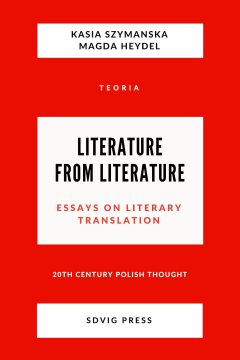This document is unfortunately not available for download at the moment.
Translation as creation
Edward Balcerzan
Translated by Kasia Szymanska
pp. 57-65
The history of literary output can be seen as a developing process in which the activities of writers and translators gradually become isolated and autonomous from each other. From this perspective, many national literatures, including that of Poland, have been constituted in two clearly distinct stages. In the first place, artistic writing is formed according to the syncretic ‘mixed’ order which approves of both original inventions and the fruits of someone else’s imagination co-existing in the same literary work. How unstable the border between creating and recreating artistic qualities transpires to be! Understanding authorship in these situations is highly problematic; coding and decoding the text involves two conflicting principles.
On the one hand, the principle of apocrypha – so to speak – comes into play; one’s own word is presented as the other’s word. In the sense that is of interest to us here, apocrypha constitute plagiarism à rebours. The translator ascribes their own thoughts and images to the author of the prototype, which was originally written in a foreign language. “The Old Slavonic booksellers,” as Dmitry Likhachov stated, “would sometimes reconstruct the composition of a translated work differently or create their own large collective compositions on the basis of translated texts.”Текстология. Moscow–Leningrad 1962, p. 390.
On the other hand, there is another factor of no lesser importance that used to stimulate writing experience in the pre-Romantic era: namely, the principle of annexation. According to this principle, the other’s word was presented as one’s own word. Appropriating a text in a foreign language resembles plagiarism and today we would indeed speak of plagiarism in such cases. The Classicist system, however, allowed for paraphrasing foreign works – most often individual episodes or other constituent parts – with a minimal degree of innovation. In some instances, it was enough for the appropriated word to make its way into a new language, style, or genre.
Pisarze polscy o sztuce przekładu 1440-1974, E. Balcerzan (ed.),
Poznań 1976, p. 68.
– admitted the seventeenth-century Polish Baroque poet Wespazjan Kochowski, with a disarming honesty. As can be seen, the principle of annexation leads us to study the “original” Classicist works as fruits of covert translation. “Not even literary history suggests the traditional notion,” Walter Benjamin wrote, “that great poets have been eminent translators and lesser poets have been indifferent translators.”The Translation Studies Reader, L. Venuti (ed.), London–New York 2004, p. 19.
Romanticism disparages what Adam Mickiewicz, a Polish poet of the Romantic period, called “the school of imitators and translators.”Dzieła, Vol. 5. Warsaw 1955, p. 269.
Firstly, the system of transformative devices becomes curiously asymmetrical. Let us assume that the translation process activates the aforementioned fundamental types of transformation: reduction, inversion, substitution, and amplification. If so, we need to notice that they are situated at unequal distances from, and in unequal relations with, the courses of “creation.” Reduction occurs not so much in dealing with the text creatively, but mainly in censoring it. Inversion seems a more creative device than reduction, but less so in comparison with substitution (exchanging elements of a text). Undoubtedly, any evaluation of a “creative” moment always needs to focus on a particular literary situation; however, the discussion above is of the most general and typological character. From a typological perspective, translatorial “creativity” is most saliently manifest in amplification. It involves supplementing the text with components that are absent from the original and do not result from any compensation for losses in case a relatively equivalent translation cannot be reached. And in fact, it is this very manifestation of creativity that would be most ruthlessly criticized in contemporary times. Reduction can be pardoned, but amplification always raises voices of protest. Korney Chukovsky scathingly called it otsebiatina, which in Russian means inventions coming “from oneself.” It is thus no coincidence that the translator Irinarch Vvedensky became an anti-hero of Russian translation history. In 1930, Chukovsky wrote that “Irinarch Vvedensky’s main guilt is his passionate love for otsebiatina additions. As soon as he starts imagining that Dickens has languished and wasted away, he comes to write in Dickens’ stead, to supplement and correct his text.”Искусство перевода. Leningrad 1930, p. 78.
Secondly, this asymmetry encompasses the structure of the text. The higher the layer of this structure, the fewer possibilities for creative inventions there are on the translator’s part. I have already highlighted the Classicist convention, which hardly objected to such inventiveness in the realm of the world depicted. When, in 1566, Łukasz Górnicki published his Polish remake of Il Cortegiano entitled The Polish Courtier, he did not need much justification for freely remolding the characters’ different patterns of behavior. “Castiglione wrote in the Italian language and wrote for Italians whose customs are far different from ours,” Górnicki argued. He then elaborated as follows:
Here, one does not love each other from the window; neither are adequate comedies nor such tragedies produced that could accustom Poles (that is, those who don’t have literas) to what a histrio is. Here, the masquerades do not proceed in the Italian way. The gentry does not play the violin or the fife; and even if some tend to, they do so once in a blue moon. Likewise, nothing is known about those French degenerates with their lords. And thus, I did not deem it appropriate to render all that in the Polish.
Reductions almost automatically paved the way for amplifications. Surprisingly, the very same transformations are nowadays a privilege of intersemiotic translation, manifest especially in the practice of adaptation for performing arts, in film and, ever more intensely, in theatre. The disappearing of characters, or splitting them into two (as in the case of Juliusz Słowacki’s play Kordian, when staged by Adam Hanuszkiewicz), alternations to the plot, etc., are out of the question in literary translation nowadays. How would critics receive a translation of Anton Chekhov’s Три сeстры́ (Three Sisters) if the translator decided on four sisters, or two, or started spinning a tale about three brothers? However, a theatre performance quite often metamorphoses a literary text in a similar manner. Within the realm of literature, if translation does not quite seem to contradict, then it at least considerably restrains, the creative process. Excess of invention is treated as a mistake, carelessness, betrayal of the original idea. “When translating poems,” Valery Bryusov would explain himself, “you yield to an artistic impulse, one may say that what you do is ‘create’; and in this way, voila! you lose the ability of assessing critically what you write in terms of a ‘translation’.” But at the same time, this restriction of creative liberties – and does it take place solely due to the lack of terminological discipline? – does not abolish the belief that translation is art. Presumably, the term “the art of translation” positively influences the translators’ well-being, which in turn depends on the contemporary horizon of the audience’s expectations. Readers put their trust in the text following what they presuppose about the origins of a given work. They want to believe that the work in question is a fruit of conscious and deliberate creative action, rather than an effect of sheer happenstance. Admittedly, literary communication knows of deviations from this norm. Practiced among the lowest echelons of mass culture, commercial literature has taught us how to be indifferent to the work’s authorial, individual, and creatively unique genesis. On an incommensurably smaller scale of social impact, Dadaism revealed that chance can be an attractive stimulus of creative process. These cases notwithstanding, it is still the Romantic canon that prevails today, which assumes that the authentically valuable artistic work has to emanate from the author’s unfeigned experience. The deeper it reaches into the most intimate biography of the master of words, the greater value it possesses.Note added in 1997: This is what I thought in the early 1980s. From today’s perspective, I wouldn’t formulate this statement in such a radical way. The Romantic model coexists with the postmodern one; the latter contradicts the first and purports to be the triumphant ‘tomb’ of the author (i.e. announcing the author’s ‘death’). The postmodern paradigm attempts to popularise the belief that ‘we’ve seen it all’ and so, since it is only possible to produce combinations of past forms and concepts, it doesn’t matter who these producers of contemporary literary installations, collages, contemporary silvae, and centos are.
When we discuss the issue of ‘translation as creativity’, things get more complicated inasmuch as the category of “creativity” is ambiguous and historically determined. According to the Polish philosopher Władysław Tatarkiewicz, it may function as a “useful phrase,”Dzieje sześciu pojęć, Wasaw 1975, p. 311.
two types of linguistic situation: the standard (stable) and the variable (changeable) ones. In the standard situations, the actions of an individual are subject to strict rationing […]. The variable (changeable) ones, however, are unique in offering a larger or smaller scale of choice from among available linguistic devices.Современная социолингвистика, Moscow 1977, p. 15.
This would be the basic “zero” level of separating the “creative” and “non-creative” activities. We may expand Shveitser’s remarks with one more reflection: texts created in stable situations (which prevent any creative innovation) are subordinate to the external norms of verbal communication. The issue of whether a text is correct or incorrect is entirely controlled from the point of view of language as a social institution. The experts who ‘know better’ whether or not it is allowed to speak in a particular manner in a given standard situation are anonymous. The concept of ‘error’ appears here as something entirely legitimate, and so the speaker feels justified in correcting a wrongly phrased text straightaway. On the other hand, the utterance that comes into being in the variable situation becomes creativity par excellence – provided that an individual questions external norms. Objecting to subordination to norms, which all of a sudden prove helpless against the need for individual expression, is a first step into creative work. Without exceptions, all language decisions are resolved on the border between correctness and incorrectness. Each word may turn out to be an artistic error, though still meeting the demands of correctness dictated by practical norms. The situation of a word in the creative process equals that of a neologism. What I have in mind are not only the extreme attacks of literary art on the institution of language in the style of зáумь (zaum) poetry or Joyce’s experiments; the most common sentence can lose its feature of ‘commonness’ and, so to speak, fall into the situation of metaphor. The first sentence of Mikhail Bulgakov’s Мастер и Маргарита (The Master and Margarita) in the Russian original reads as follows: V chas zharkogo vesennego zakata na Patriarshikh Prudakh pojavilis dvoe grazhdan [During the hot spring sunset, two citizens appeared in the Patiarch’s Ponds].Москва 11, 1999, p. 7.
Kiedy zachodziło właśnie gorące wiosenne słońce, na Patriarszych Prudach zjawiło się dwu obywateli [Just as the hot spring sun was setting, two citizens appeared in the Patriarch’s Prudy]? Such an equivalent of the Russian sentence was proposed by Irena Lewandowska and Witold Dąbrowski, the Polish translators of The Master and Margarita.Mistrz i Małgorzata, trans. I. Lewandowska, W. Dąbrowski, Warsaw 1969, p. 7.prud is not only a part of the local name, but also a visual suggestion. In Russian, prud is a pond, a small pool of muddy water; and indeed, the fate of the “two citizens” is going to get muddied up quite soon. What disappears in Lewandowska and Dąbrowski’s translation is the irony achieved by juxtaposing high and low registers: “the time of hot sunset” and a “muddy pond”, the “muddy pond” and the “patriarch.” Repeated after the Russian original, the word prud adapted into Polish does not spark the associations projected within the source text. Let me stress, however, that in raising these doubts here, I do not intend to enter into a polemic with the translators. Something else is rather of interest to us here, namely the perpetual state of doubt that appears unfailingly in every reading of a translation, and even earlier on: in every attempt to translate a literary text. Thus, the most elementary translation activities occur in the clearly variable situation; they take such a situation for granted.
The Master and Margarita’s initial pages heading to the kiosk that sells “Beer and soft drinks.” Due to supply shortages, they’ve got no mineral water and no beer, only an apricot drink. Nu davayte, davayte, davayte, e!,Москва 11, 1999, p. 8. No, dawajcie, dawajcie, dawajcie sounds like an unquestionably poor solution – it would be a phraseological Russicism. Furthermore, according to the colloquial use of language, the Russian verb davat’ is a way to urge a person to do any one of many different things, something that cannot be confined to the connotative field of the Polish dawać [to give]. The translator needs to invent, arrange, and construct an equivalent of this expression’s function. Może być. Niech będzie! [Fair enough, let it be!],Mistrz i Małgorzata, trans. I. Lewandowska, W. Dąbrowski, Warsaw 1969, p. 8.Patriarsze Prudy. An immense multitude of possible solutions is at stake here, for instance: Dobra jest, dobra jest, dobra jest [Al-right, al-right, al-right…] or No to prędzej, prędzej, prędzej [So hurry up, hurry up…], etc.
- Balcerzan Edward (1977) Pisarze polscy o sztuce przekładu (1440-1974): Antologia, Poznań, Wydawnictwo Poznańskie.
- Bulgakov Michajl (1969) Mistrz i Małgorzata, Warszawa, Czytelnik.
- Bulgakov Michajl (1999) Master i Margarita, Moskva, AST.
- Lichačev Dmitrij S (1962) Tekstologija: na materiale russkoj literatury X-XVII vv, Moskva, Izdatel'stvo Akademii Nauk SSSR.
- Mickiewicz Adam (1955) Pisma filomatyczne estetyczno-krytyczne opowiadania (edited by Krzyżanowski Julian), Warszawa, Czytelnik.
- Švejcer Aleksandr Davidovič (1977) Sovremennaja sociolingvistika: teorija, problemy, metody, Moskva, Nauka.
- Tatarkiewicz Władysław (1975) Dzieje sześciu pojęć: sztuka, piękno, forma, twórczość, odtwórczość, przeżycie estetyczne, Warszawa, Państwowe Wydawnictwo Naukowe.



